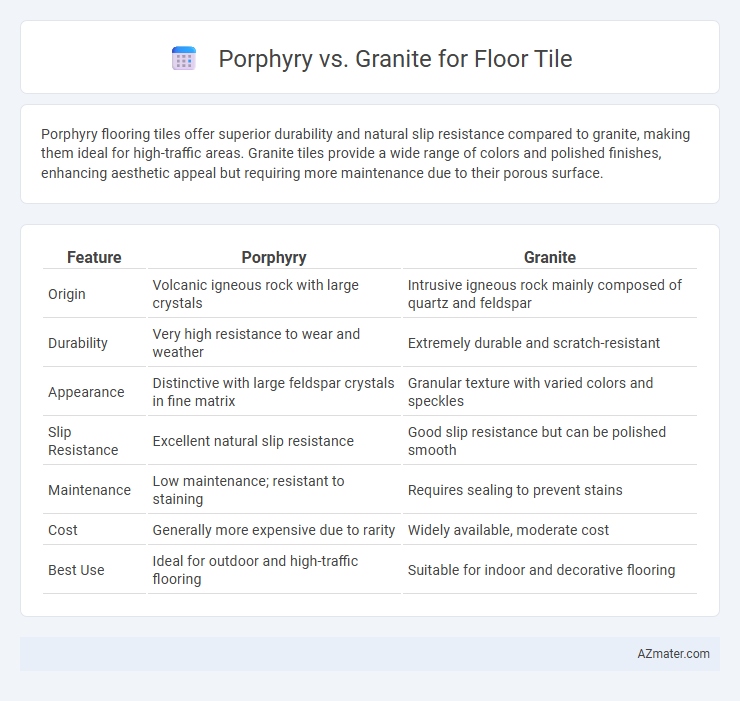Porphyry flooring tiles offer superior durability and natural slip resistance compared to granite, making them ideal for high-traffic areas. Granite tiles provide a wide range of colors and polished finishes, enhancing aesthetic appeal but requiring more maintenance due to their porous surface.
Table of Comparison
| Feature | Porphyry | Granite |
|---|---|---|
| Origin | Volcanic igneous rock with large crystals | Intrusive igneous rock mainly composed of quartz and feldspar |
| Durability | Very high resistance to wear and weather | Extremely durable and scratch-resistant |
| Appearance | Distinctive with large feldspar crystals in fine matrix | Granular texture with varied colors and speckles |
| Slip Resistance | Excellent natural slip resistance | Good slip resistance but can be polished smooth |
| Maintenance | Low maintenance; resistant to staining | Requires sealing to prevent stains |
| Cost | Generally more expensive due to rarity | Widely available, moderate cost |
| Best Use | Ideal for outdoor and high-traffic flooring | Suitable for indoor and decorative flooring |
Introduction to Porphyry and Granite Floor Tiles
Porphyry floor tiles are volcanic igneous rocks characterized by large crystal grains embedded in a fine-grained matrix, known for their durability and rich, reddish-brown hues. Granite floor tiles, composed of quartz, feldspar, and mica, offer exceptional hardness and a speckled, natural stone appearance with a wide range of colors from gray to pink. Both materials provide excellent resistance to wear, making them ideal for high-traffic flooring applications.
Key Differences Between Porphyry and Granite
Porphyry features large, visible crystals embedded in a finer matrix, offering a unique, textured appearance, whereas granite is characterized by a uniform granular composition with interlocking mineral grains. Porphyry is typically more resistant to abrasion and weathering, making it ideal for outdoor flooring, while granite provides higher durability and a polished finish preferred for indoor tiles. The color variation in porphyry tends to be more striking with bold contrasts, compared to granite's often consistent and speckled patterns.
Appearance and Aesthetic Qualities
Porphyry floor tiles exhibit a distinctive appearance marked by large, angular crystals embedded in a fine-grained matrix, creating a striking contrast with deep reds, purples, and browns that lend an elegant and timeless aesthetic. Granite tiles, known for their granular texture with a speckled pattern of quartz, feldspar, and mica, offer a wider color palette ranging from light gray to black, often providing a more uniform and polished look. The choice between porphyry and granite for flooring largely depends on desired visual impact, where porphyry adds dramatic texture and color variation, while granite provides sleekness and subtle sophistication.
Durability and Lifespan Comparison
Porphyry offers superior durability with a Mohs hardness of 6-7, making it highly resistant to scratches and heavy foot traffic, ideal for floor tiles in high-traffic areas. Granite, with a similar hardness of 6-7, is also extremely durable but generally less resistant to acid stains and chemical damage compared to porphyry. Both materials provide excellent lifespan options for floor tiles, typically lasting decades with proper maintenance, though porphyry's natural toughness often results in a longer, more resilient performance in demanding environments.
Slip Resistance and Surface Texture
Porphyry offers superior slip resistance for floor tiles due to its naturally rough and uneven surface texture, making it ideal for high-traffic and wet areas where safety is critical. Granite has a smoother surface, which can become slippery when wet unless treated with anti-slip finishes, reducing its effectiveness in environments prone to moisture. The coarse grain structure of porphyry provides better traction compared to the polished or honed surface of granite tiles.
Maintenance Requirements for Each Material
Porphyry floor tiles require low maintenance due to their dense, hard composition that resists staining and wear, needing only regular sweeping and occasional mopping with pH-neutral cleaners. Granite tiles also offer durability but demand more frequent sealing to prevent moisture penetration and staining, especially in high-traffic areas. Both materials benefit from prompt spill cleanup, but porphyry's natural resistance reduces long-term maintenance efforts compared to granite.
Installation Process: Porphyry vs Granite
Porphyry floor tile installation requires precision cutting due to its natural hardness and uneven texture, often necessitating diamond-tipped blades and skilled labor to ensure seamless fitting. Granite tiles, while also dense and durable, are generally easier to cut and shape with standard stone-cutting tools, facilitating a quicker installation process. Both materials demand a strong adhesive and professional grout application to handle their weight and maintain stability over time.
Cost Analysis and Budget Considerations
Porphyry floor tiles generally come at a higher cost compared to granite due to their rarity and unique texture, making them a premium choice for upscale projects. Granite offers a more budget-friendly option with widespread availability and durability, often reducing overall installation and maintenance expenses. When planning flooring budgets, considering the long-term value and aesthetic impact of porphyry against the cost-effectiveness and resilience of granite is essential.
Environmental Impact and Sustainability
Porphyry floor tiles demonstrate superior environmental sustainability compared to granite due to their lower energy consumption during quarrying and processing. Porphyry's durability reduces the frequency of replacement, minimizing resource depletion and waste generation over time. Granite extraction often involves higher carbon emissions and water usage, making porphyry a more eco-friendly choice for sustainable flooring projects.
Best Applications and Design Recommendations
Porphyry floor tiles excel in outdoor applications due to their high durability and slip resistance, making them ideal for patios, walkways, and high-traffic commercial spaces. Granite tiles are best suited for indoor flooring where aesthetic appeal and strength are priorities, such as kitchens, bathrooms, and entryways, thanks to their polished finish and stain resistance. Design recommendations suggest using porphyry's rich, earthy tones to complement rustic and natural themes, while granite's wide color range and sleek appearance enhance contemporary and luxury interiors.

Infographic: Porphyry vs Granite for Floor Tile
 azmater.com
azmater.com